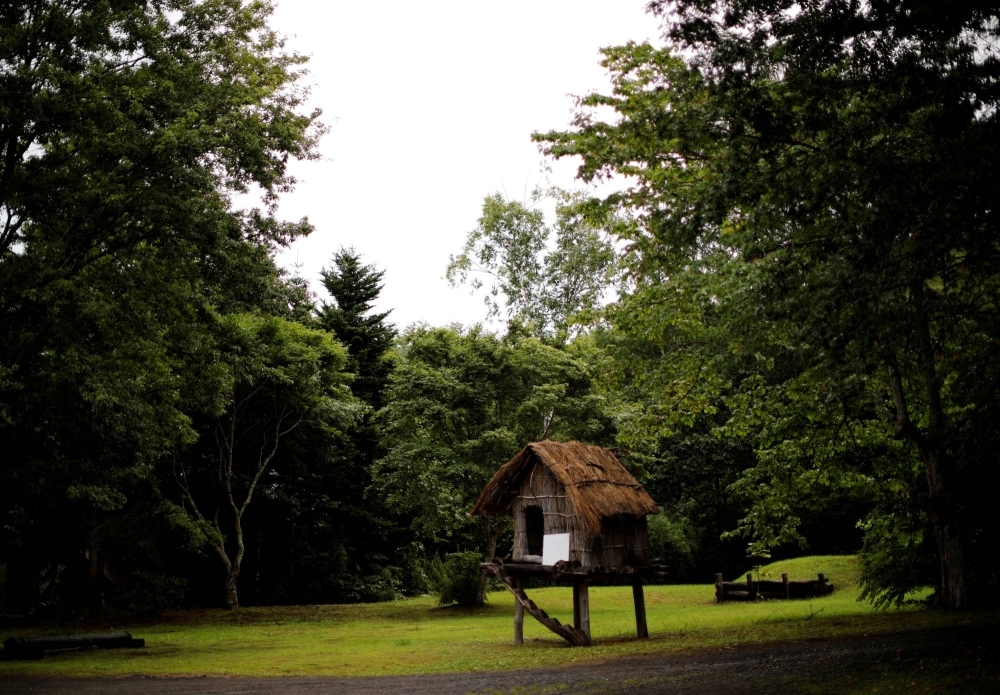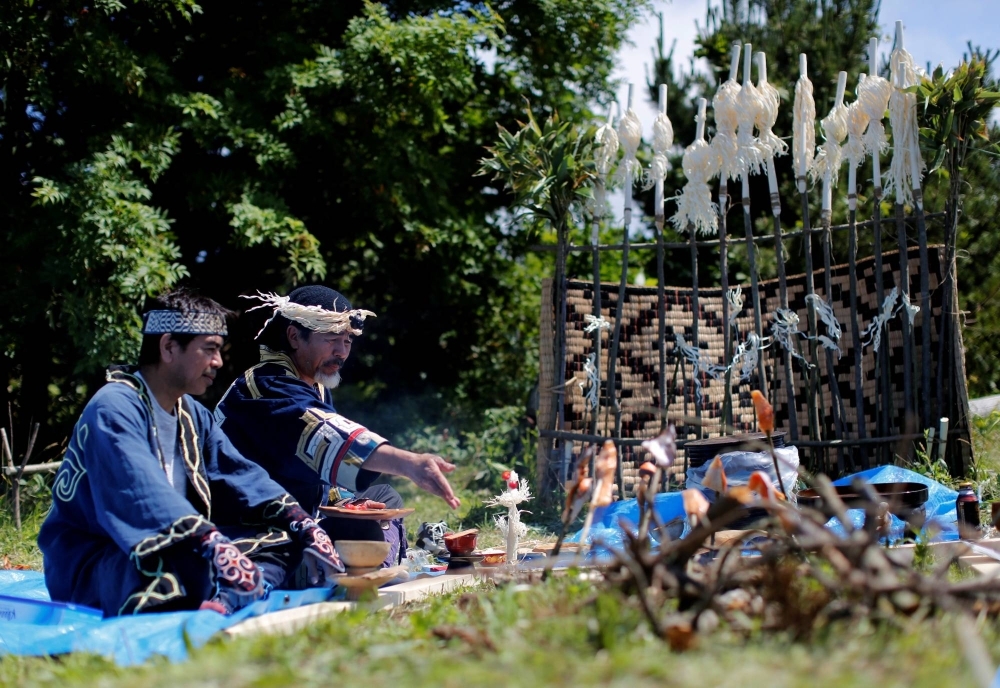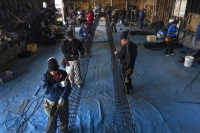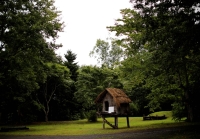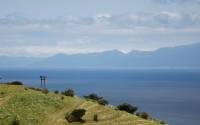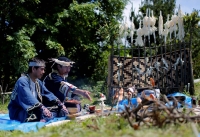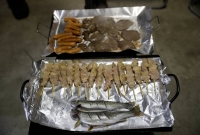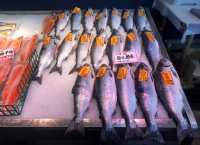As Hokkaido prepares for the beginning of the autumn salmon runs, a lawsuit by an Ainu Indigenous group over traditional fishing rights and the impacts of climate change on stocks are hanging over the annual fishing season.
The unprecedented lawsuit by the Raporo Ainu Nation to claim their traditional Indigenous rights to catch the prized fish comes as estimated salmon stocks hover at around half of what they were just two decades ago, with rapidly warming waters in the Sea of Okhotsk and northern Pacific potentially upending migration patterns.
The suit, which was filed in 2020 against the national and Hokkaido governments, has drawn national and international attention, because, while Japan legally recognized the Ainu people as Indigenous in 2019, it only allows the Ainu to fish for salmon for the purposes of practicing cultural tradition — not for economic reasons.
The lawsuit argues that the ancestors of the Raporo Ainu Nation engaged in the commercial trading of salmon in the area with Japanese during the Edo Period (1603-1867). But as Japan began a period of rapid industrialization during the Meiji Era (1868-1912), the Ainu were removed from their land and banned from commercial hunting and fishing.
During the 20th century, they suffered from extreme discrimination following the passage of an 1899 law that, in an attempt to assimilate the Ainu into Japanese society, forced them to take up farming for a living instead of relying on hunting and fishing for trout and salmon, which they were already banned from doing in the Sapporo area through an 1878 law. The 1899 law also determined how land was to be distributed to the Ainu and imposed strict limits on how it could be legally transferred.
That law was not repealed until 1997, when a new law that aimed to promote Ainu culture was passed. But it would not be until 2007, following the adoption by the United Nations General Assembly of The U.N. Declaration on the Rights of Indigenous Peoples, that Japan moved to address the question of whether the Ainu were Indigenous. In June 2008, one month before the Group of Seven leaders summit in Hokkaido, parliament passed a resolution declaring that they were Indigenous.
The 2019 law went further, promising to create a society that respects the pride of the Ainu. But critics say the law was heavy on symbolism but light on substance, and stopped short of acknowledging that the Ainu have traditional rights to hunt and fish under the U.N. declaration that Japan signed.
The Ainu’s case that Japan is not abiding by the declaration would appear to be clear-cut.
Under Article 25 of the U.N. declaration, “Indigenous peoples have the right to maintain and strengthen their distinctive spiritual relationship with their traditionally owned or otherwise occupied and used lands, territories, waters and coastal seas.”
In addition, Article 26 outlines “they have the right to own, use, develop and control the lands, territories and resources that they possess by reason of traditional ownership or other traditional occupation or use.”
Masaki Sashima and the Raporo Ainu Nation he represents argue that, because the Urahorotokachi River is part of the group’s traditional fishing waters, they have inherited the right to fish there today. Specifically, the Raporo Ainu Nation is fighting for the right to catch salmon using gill nets within 4 kilometers of the mouth of the river, which empties into the Pacific about 80 southwest of Kushiro.
The lawsuit is in the Sapporo District Court, but it’s not clear when a verdict will arrive. The Japanese government's position, Sashima says, is that the law doesn’t recognize Indigenous land rights.
“In most other countries, Indigenous peoples have what's called native rights or Indigenous rights. However, the Japanese government is saying those rights are not a part of current Japanese law,” Sashima told the Foreign Correspondents’ Club of Japan in May.
The Raporo Ainu Nation’s struggle to claim their Indigenous rights comes at a time when attention is turning toward how climate change is affecting the oceans and catches of seafood, including salmon, around Hokkaido.
The Hokkaido Research Organization’s Fisheries Research Department reported that in 2022, the total number of migrating autumn salmon in Hokkaido waters was 33.47 million, up 180% from the previous year and exceeding 30 million for the first time in seven years.
While the number of salmon last year increased overall compared to the previous year, the figure is still down significantly from around two decades ago, when yearly migrations were between 50 million and 60 million.
The average salmon in 2022 weighed 2.83 kg, a significant decrease from the previous year's 3.19 kg, and the smallest in recent years.
Makoto Fujiwara, an official with the Hokkaido Research Organization, said the exact reasons for the overall decline are not entirely clear, but that it’s believed overfishing is not impacting the numbers. The prefecture has a regulatory system in place to ensure there are sufficient numbers of salmon hatchlings, and puts limits on salmon fishing if the numbers are insufficient. Fujiwara added that although this year’s forecast for Hokkaido is 34.83 million salmon, a changing marine environment means future trends are not clear.
“It will be necessary to keep a close watch on the marine environment of the Bering Sea and the Gulf of Alaska in particular,” he says, which is where the salmon migrate from.
The prefectural government predicts climate change will continue to heavily impact Hokkaido in the coming years. In a high global emissions scenario, a 5 degrees Celsius average temperature rise by the end of this century would mean more intense squalls and less snowfall, while warmer seas around the island would disrupt the migratory patterns of fish.
This includes the Sea of Okhotsk on the north side of Hokkaido. The Japan Meteorological Agency's latest report says that it is “virtually certain that the maximum sea ice extent in the Sea of Okhotsk follows a long-term trend of reduction by which an area equivalent to 3.5% of the sea's total area is lost per decade between 1971 and this year.”
It adds that global warming may have contributed to this trend, but that longer-term data is needed to confirm a relationship between global warming and the extent of the reduced sea ice observed in the Sea of Okhotsk.
But scholarly experts have long been worried about the loss of sea ice and the resulting impact on marine life.
In a January 2009 report on conditions in the Sea of Okhotsk, lead author Kay Oshima, a professor at Hokkaido University’s Institute of Low Temperature Science, warned that over the previous three decades, sea ice had decreased by about 150,000 square kilometers, 10% of its total area, and that sea surface temperatures had risen by approximately two degrees over 50 years. A lack of sea ice has a significant impact on the health of the marine environment.
“When sea ice is formed, most of the salt content is rejected from the ice and thus cold and saline water is released into the ocean below,” the report said.
The denser seawater then circulates to deeper layers of the ocean, essentially making the Sea of Okhotsk the “heart pump of the North Pacific,” a status that’s threatened as the amount of sea ice declines.
“To put it simply, recent global warming has weakened the Sea of Okhotsk’s workings as a pump,” Oshima said in the report.
A major consequence is the poor circulation of iron — an important nutrient for marine life — which in turn has an effect on biological productivity.
Of the 33.47 million salmon migrating in Hokkaido waters last year, 20.3 million were in waters along the Sea of Okhotsk coast.
The environmental and economic concerns over future salmon stocks in Hokkaido’s waters are clear. But for the Ainu people, the fish plays a much larger cultural role.
Each year, in the late summer or early autumn, the Ainu celebrate Kamuycepnomi, an elaborate ceremony that honors the return of salmon to Hokkaido’s rivers. But ahead of the ceremony, the Raporo AInu Nation and other Ainu groups have to apply for a permit to catch a small number of salmon for traditional or cultural purposes, rather than economic reasons. Sashima says that in recent years, the Raporo Ainu Nation has only been allowed to catch 100 salmon a year.
Applications are handled through local Hokkaido towns and villages as well as the local chapters of the Ainu Association of Hokkaido. Between 2020 and 2022, about 2,000 salmon per year were allowed to be taken by all Hokkaido Ainu for traditional and cultural reasons.
Hokkaido Gov. Naomichi Suzuki has said there are no plans to change the permit system, which leaves the Raporo Ainu Nation with few alternatives beyond its legal challenge.
As Hokkaido continues to monitor how the surrounding seas are impacting all marine life, allowing Ainu groups the right to become part of Hokkaido’s salmon fishing industry might also open the door for the industry as a whole to adopt better, more environmentally sustainable methods for salmon fishing that are based on Ainu attitudes about the natural environment and the importance of letting nothing go to waste. For example, salmon and wildlife like deer were not only food staples, but their skin was used to make clothes, shoes, and bags.
“We want the salmon to reproduce in the river. If they can manage to get the parent fish upstream in the autumn, they can lay their eggs there. That will allow more of them to flow down the river back to the sea once spring arrives,” says Sashima when asked about how Ainu people traditionally managed fish stocks.
“We Ainu regard salmon as a fish that was given to us by the gods as well as a very important food staple.”




